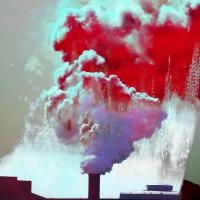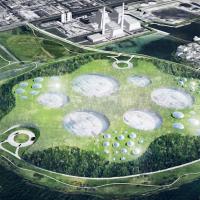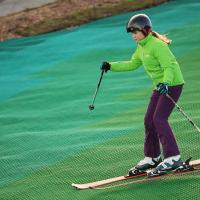As the agriculture industry largely exists today, food is produced and processed on farms far outside of major cities, and then shipped into large population centers. In fact, one out of every four freight trucks on the road at any given time is transporting food to urban settings.
This practice is not only bad for environmental air quality, it’s also risky. If these trucks stopped running, which they often do during natural disasters, it’s estimated that grocery stores located in cities would run out of food in just three days.
Inspired by the 2012 food shortages witnessed in New York City following Hurricane Sandy, husband and wife team Peter and Minke van Wingerden came up with the idea for a sustainable farm that floats on the sea.
Designed to produce food where there’s the greatest demand – inside a city – the Wingerdens’ three-story floating dairy farm bobs idyllically in the Netherlands’ Port of Rotterdam, an innovative beacon of sustainable agriculture.
The Importance of Sustainable Agriculture
To grasp the enormity of the breakthrough that the Wingerdens’ floating farm represents, the challenges posed by sustainable agriculture must be part of the conversation.
You might be wondering, what is sustainable agriculture? The goal of sustainable agriculture is to produce enough food, and textiles, so that our present needs are met while using practices that preserve our resources, so that the needs of future generations will also be met.
Sustainable farming practices are economically viable, ecologically sound, and socially supportive (beneficial to farmers, their families, and their communities). Such practices include crop rotation and the integration of mutually beneficial crops with animals on a farm, for example.
Sustainable agriculture also aims to make use of byproducts, typically considered to be waste, in order to maximize production. These principles attempt to create a closed-loop within a farm’s ecological system to minimize total waste.
The Wingerdens’ floating farm takes this to another level by following sustainable urban agriculture best practices, eliminating the need for cross-country freight by cultivating, processing, and distributing food in and around urban centers.
In other words, food is produced where it’s consumed. This includes both growing produce and animal husbandry practices, such as raising dairy cows and chickens.
Port of Rotterdam’s First Floating Farm
In a crowded city, one of the primary challenges with sustainable urban farming is simply finding the space to humanely raise animals or to cultivate produce. Cities by the sea, however, now have the option of expanding their sustainable urban agriculture over the water.
The Wingerdens’ floating farm is exactly what it sounds like: a dairy farm, floating on a platform in the Port of Rotterdam. The structure consists of three stories. The lowest level floats beneath the water’s surface, creating a cool space for storage. The second level features the dairy production area (for pasteurizing and bottling). The top level is outfitted with spacious stables, a squishy rubber floor, and rubber piping to keep dairy cows safe as they move about.
To top it off, the floating farm’s roof is designed to gather and filter rainwater for the cows to drink. And adjacent to the dairy farm float is a float consisting of solar panels, which provide ample natural energy to power the entire dairy farm’s production.
This floating dairy farm provides products and fertilizer to the city, while the city supports its production with biowaste that would normally be thrown out. This includes cut grass from local playing fields and golf courses, plus the waste from local breweries. The farm’s cows eat the plant-based waste, essentially upcycling the nutrients into food for human consumption.
How Many People Could Floating Farms Actually Benefit?
According to statistics presented at the United Nations 2017 Ocean Conference, an estimated 2.4 billion people live within 60 miles of a coastline. This means roughly 40 percent of the world’s population lives close enough to benefit from the food which could be produced on floating farms lining our coasts.
As Peter Wingerden points out, there’s especially high demand for floating farms in countries where space is extremely limited, like Singapore. Locations that face flooding throughout much of the growing season, such as Bangladesh, could also benefit from floating farms, as they’re safe from flood waters and put excess rainwater to good use within the sustainable system.
The current design allows for a great amount of flexibility and scalability, in terms of meeting a community’s individual needs. A floating farm structure can be expanded wider or longer, and constructed with up to eight stories for housing various animals, gardens, production facilities, and storage facilities.
The Future of Farming at Sea
As the floating dairy farm continues to prove the concept of sustainable agriculture at sea, the Wingerdens hope to expand their production and improve sustainability. They’ll be adding a windmill to supplement the energy derived from solar power, and they’re also working on researching and development for hydrogen use as a potential energy source.
Within a year and a half, they plan to have added a floating vegetable garden and a floating chicken coup with 7,000 egg-laying hens. With these additions, they’ll be able to create a more complete ecosystem within their floating farms, hopefully producing all their own feed, energy, and water, while continuing to deliver food products back to the city.
This new way of producing sustainable agriculture solves the challenge of finding enough space to eliminate the food deserts that our cities have become. Floating farms sustain our ability to meet the nutritional needs of future generations, and they do so in an economically viable way. When you look to the future of farming, it’s likely you’ll be gazing out over the ocean, rather than the Great Plains.
For more interesting news about the people and ideas that are changing our world, subscribe to Freethink.


